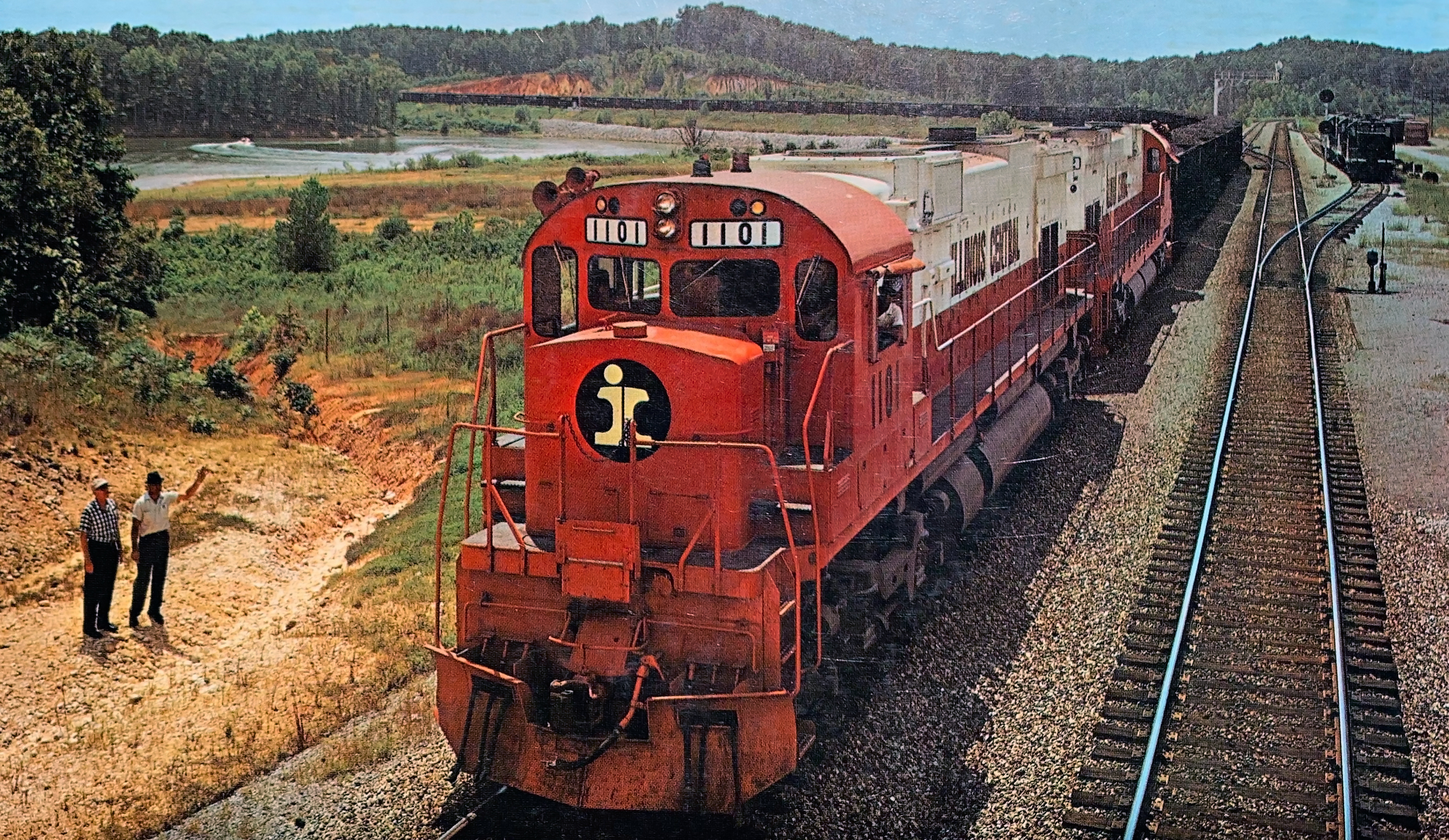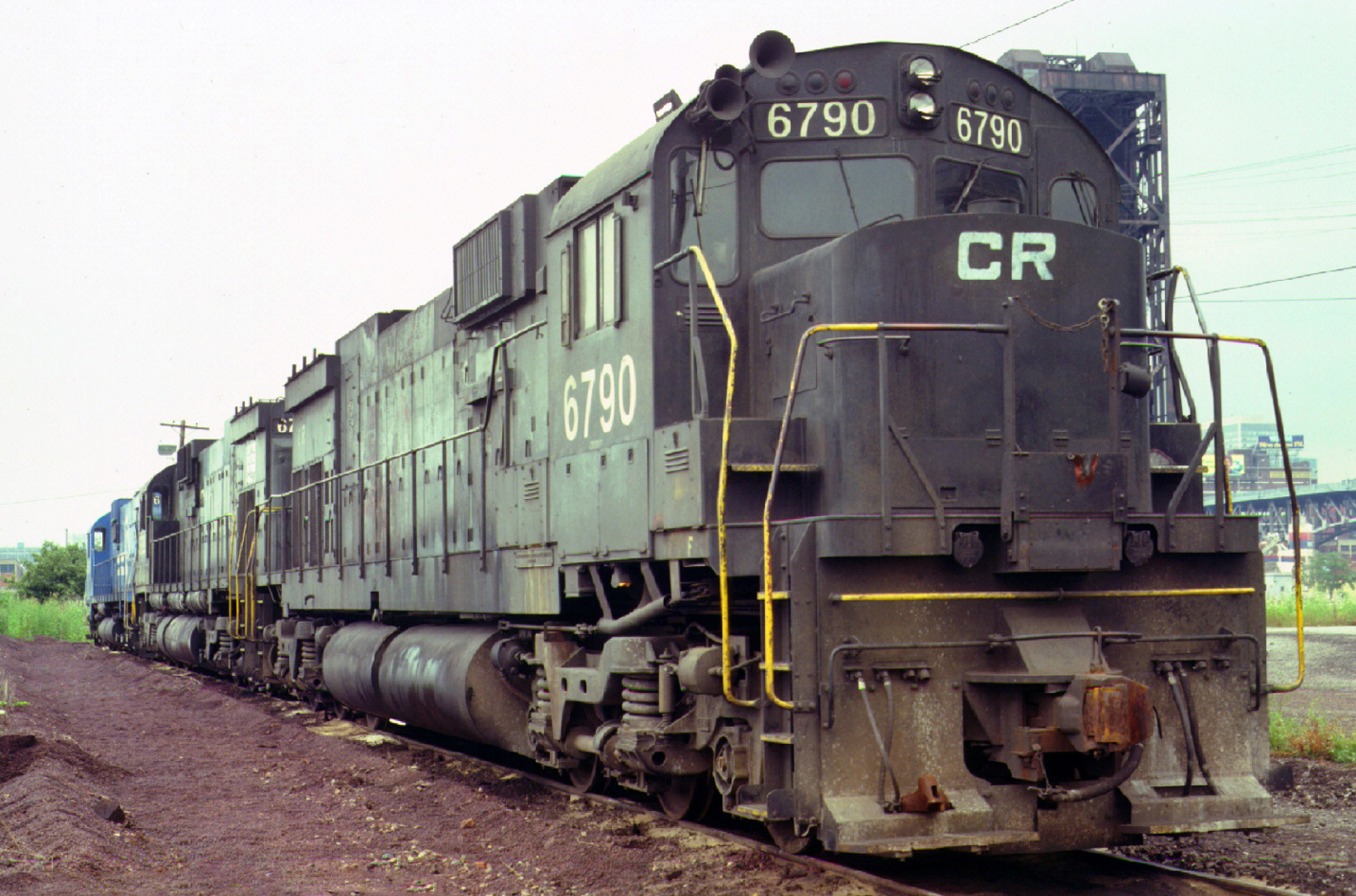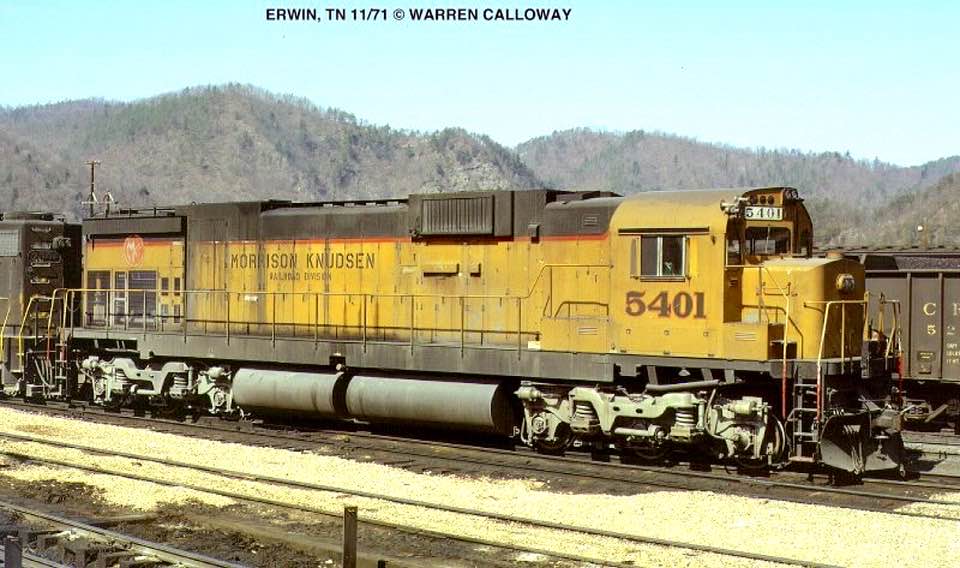Alco "C636" Locomotives: Specs, Roster, Data Sheet
Last revised: December 23, 2024
By: Adam Burns
The C636 was Alco's final and most powerful six-axle road-switcher. While nearly 100 were built, less than 40 were sold to US railroads.
Unfortunately, issues with the C636's internal mechanics, made many railroads hesitant to purchase the model, coupled with Alco's issues with its early engine variants.
Alco continued to lose market share to GM's Electro-Motive Division and General Electric from the 1950s onward (GE began building its own diesel after 1959).
Interestingly, despite few sales of the C636 (and sister M636) you can still find the locomotive in regular service on short lines Delaware-Lackawanna and Livonia, Avon & Lakeville.
Photos
 An Illinois Central publicity photo featuring a pair of its new C-636's with a long coal drag somewhere on the Kentucky Division in the summer of 1968. Author's collection.
An Illinois Central publicity photo featuring a pair of its new C-636's with a long coal drag somewhere on the Kentucky Division in the summer of 1968. Author's collection.Overview
The C636 began production in 1967 just a little over one year before the company would outshop its last locomotive.
The most powerful standard model diesel Alco ever built, the C636 could produce 3,600 horsepower using the company's 251E model prime mover.
Likely due to Alco's haste to keep pace with GE and EMD the C636 was plagued with problems that this time was not due to the prime mover.
Instead, railroads such as the Santa Fe found issues with the traction motor blower failing, which would cause the prime mover to likewise shutdown.
Ultimately, this issue and Alco's already shaky reliability in its earlier engines (539 and 244) kept many railroads from purchasing models equipped with the more rugged 251 engine.
 Conrail acquired a large fleet of these big C636's from Penn Central, which purchased 15 examples. Three are seen here tied down at the Whiskey Island Ore Docks in Cleveland, Ohio on July 24, 1978. Arnold Morscher photo.
Conrail acquired a large fleet of these big C636's from Penn Central, which purchased 15 examples. Three are seen here tied down at the Whiskey Island Ore Docks in Cleveland, Ohio on July 24, 1978. Arnold Morscher photo.Additionally, the high horsepower, six-axle locomotive market had yet to take off although by the late 1960s railroads were beginning to understand its benefits.
For instance, the industry leader at the time, Electro-Motive, sold more than 5,000 examples of its four-axle, General Purpose variants including the GP35, GP38, GP40. In contrast, similar six-axle versions sold just over 500.
However, before the decade ended, EMD released the SD40 in 1966. It was cataloged about the same time as Alco's C636 and while the SD40 produced less horsepower the industry was impressed with everything it offered. Ultimately, some 1,200 were sold before its replacement, the updated SD40-2, saw even higher sales.
As powerful as the six-axle Century line was, particularly the C636, railroads came to also dislike them as they caused significant wear to the track structure.
For instance, the C636 weighed in at 420,000 pounds while similar models built by EMD and GE weighed much less (the SD40/-2 weighed only 368,000 pounds and the U30C weighed only 363,000 pounds).
Unless a railroad used the C636s on a line that was equipped with heavy rail and a high degree of maintenance the infrastructure really took a beating from the locomotives.
Even then, most companies were turned away by the weight issues with the earlier C628 and C630. Additionally, with the industry being at its weakest point in its history during the late 1960s and through the 1970s few roads had the monetary resources or track to operate the C636.
In the end, only 83 units of the Alco C636 and M636 (built by the Montreal Locomotive Works) were sold, and of those only 31 were purchased by US railroads (Penn Central, Illinois Central, and Spokane, Portland & Seattle). Alco also built three demonstrators (#636-1, #636-2, #636-3) that were purchased by Québec Cartier Mining.
The M636s were purchased by Canadian National, Canadian Pacific, Ferrocaril del Pacfico, and Québec Cartier Mining also picked up a few more. Most of these locomotives were built by MLW after Alco had shuttered its Schenectady, New York plant.
Data Sheet and Specifications
| Entered Production | 12/21/1967 (Spokane, Portland & Seattle #331) |
| Years Produced | 12/21/1967-11/21/1968 |
| Model Specification | DL636 |
| Engine | 251F, V-16 |
| Horsepower | 3,600 |
| RPM | 1,100 |
| Carbody Styling | Alco |
| Length (Between Coupler Pulling Faces) | 69' 6" |
| Weight | 372,000 Lbs. (Optional ballasting available up to 420,000 Lbs.) |
| Dynamic Brakes | Optional |
| Trucks | C-C |
| Truck Type | Hi-Ad (High Adhesion) |
| Truck Wheelbase | 12' 6" |
| Wheel Size | 40" |
| Traction Motors | GE 752 (6) |
| Traction Generator (AC) | GTA-11 |
| Gear Ratio | 81:22 (75 MPH), 77:26 (93 MPH) |
| Tractive Effort Rating | 100,000 Lbs. at 7 MPH. |
| Top Speed | 93 MPH |
Production Roster
Alco
Total Built = 34
| Owner | Road Number(s) | Construction Numbers | Completion Date |
|---|---|---|---|
| Alco (Demo) | 636-1, 636-2, 636-3 (Acquired by Morrison-Knudsen*) | S-6008-01 thru S-6008-03 | 11/1968 |
| Illinois Central | 1100-1105 | S-6000-01 thru S-6000-06 | 5/1968 |
| Penn Central | 6330-6344 | S-3499-01 thru S-3499-15 | 3/1968-4/1968 |
| Spokane, Portland & Seattle | 330-335 | S-3488-01 thru S-3488-06 | 12/1967 |
| Spokane, Portland & Seattle | 340-343 | S-6010-01 thru S-6010-04 | 11/1968 |
* The 3 demonstrators were purchased by Morrison-Knudsen, one month prior to Alco discontinuing locomotive production. They were initially sent to Australia, numbered 5401-5403, and used in the construction of iron ore railroads according to John Kirkland's book, "The Diesel Builders: Volume Two."

They later returned to the United States (with the same numbers and an "MK" livery) and spent time as leased units on various railroads, such as the Clinchfield (seen above in a Warren Calloway photo taken in November, 1971 at Erwin, Tennessee).
The trio was eventually acquired by Québec Cartier Mining, numbered 77-79, and handled heavy ore trains for many years.
A.E. Goodwin
| Owner | Road Number(s) | Construction Number(s) | Completion Date |
|---|---|---|---|
| Cliff's Robe River Iron Associates | 262.001-262.005 | G-6060-01 thru G-6060-05 | 2/1971 |
| Cliff's Robe River Iron Associates | 1715 | G-6060-06 | 2/1972 |
| Hamersley Iron | 2006-2007 | G-6011-01 thru G-6011-02 | 4/1968 |
| Hamersley Iron | 2008-2011 | G-6014-01 thru G-6014-04 | 12/1968 |
| Hamersley Iron | 2012 | G-6028-01 | 7/1969 |
| Hamersley Iron | 2013 | G-6040-01 | 7/1970 |
| Hamersley Iron | 2014-2017 | G-6043-01 thru G-6043-04 | 10/1970-11/1970 |
| Mt. Newman Mining | 5452-5456 | G-6012-01 thru G-6012-05 | 6/1972 |
| Mt. Newman Mining | 5457-5459 | G-6027-01 thru G-6027-03 | 6/1969-8/1969 |
| Mt. Newman Mining | 5460-5464 | G-6035-01 thru G-6035-05 | 12/1969-4/1970 |
| Mt. Newman Mining | 5465-5468 | G-6041-01 thru G-6041-04 | 7/1970-8/1970 |
Montreal Locomotive Works
| Owner | Road Number(s) | Construction Number(s) | Completion Date |
|---|---|---|---|
| Canadian Pacific | 4700-4728 | 6031-01 thru 6031-29 | 11/1969-10/1970 |
| Canadian National | 2300-2319 | 6037-01 thru 6037-20 | 4/1970-9/1970 |
| Canadian Pacific | 4729-4743 | 6038-01 thru 6038-15 | 10/1970-12/1970 |
Sources
- Foster, Gerald. A Field Guide To Trains. New York: Houghton Mifflin, 1996.
- Kirkland, John F. Diesel Builders, The: Volume Two, American Locomotive Company And Montreal Locomotive Works. Glendale: Interurban Press, 1989.
- Pinkepank, Jerry A. Diesel Spotter's Guide. Milwaukee: Kalmbach Publishing Company, 1967.
- Solomon, Brian. Alco Locomotives. Minneapolis: Voyageur Press, 2009.
The primary difference between the M636 and the C636 was that the former rode on Dofasco trucks while the latter featured high adhesion trucks. British Columbia Railway's M636's also came equipped with wide cabs.
Interestingly, for the early problems the C636 suffered a handful still operate around the country. Short line Delaware-Lackawanna operates an astounding three C636s and three M636s. Also, short line Western New York & Pennsylvania operates three M636s and uses a former C636 for parts.
Contents
Recent Articles
-
North Carolina Father's Day Train Rides: A Complete Guide
May 06, 25 12:40 AM
Celebrating dad on a scenic train in North Carolina can be found at the New Hope Valley Railway which hosts a special event for the day. -
New Jersey Father's Day Train Rides: A Complete Guide
May 05, 25 11:01 AM
There are a few locations in New Jersey celebrating dads with a train ride. Learn more about these unique trips here! -
New Jersey Mother's Day Train Rides: A Complete Guide
May 05, 25 10:33 AM
The recently launched Woodstock Central Railroad in southern NJ is the only location hosting an event just for mom. Learn more about this attraction here!


